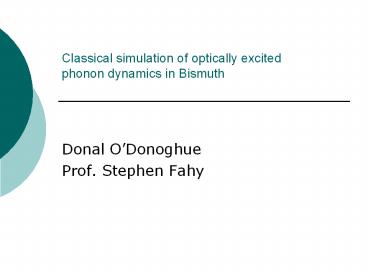Classical simulation of optically excited phonon dynamics in Bismuth - PowerPoint PPT Presentation
1 / 28
Title:
Classical simulation of optically excited phonon dynamics in Bismuth
Description:
Classical simulation of optically excited phonon dynamics in Bismuth Donal O Donoghue Prof. Stephen Fahy Talk outline Coherent phonons & optically excited Bismuth ... – PowerPoint PPT presentation
Number of Views:195
Avg rating:3.0/5.0
Title: Classical simulation of optically excited phonon dynamics in Bismuth
1
Classical simulation of optically excitedphonon
dynamics in Bismuth
- Donal ODonoghue
- Prof. Stephen Fahy
2
Talk outline
- Coherent phonons optically excited Bismuth
- Project motivation and goals
- Theory lattice vibrations, dynamical matrices,
anharmonic phonon decay - Classical simulation of dynamics
- Preliminary results
3
What is a phonon?
- Vibration of a crystal lattice
- Wave like stretching and deformation of
inter-atomic bonds - Acoustic and Optic modes of longitudinal and
transverse waves
4
Creating coherent phonons
- At thermal equilibrium, coherent phonons are
unlikely to exist - A femtosecond light pulse can induce coherent
atomic motion over a macroscopic region
5
Decay of coherent phonons
- Coherent phonons can decay due to coupling with
electrons and other phonon modes, and due to
scattering by crystal impurities and defects
6
Pump probe experiments
7
Bismuth general properties
- Element 83, atomic mass 209 g/mol
- Semi-metal, similar to Antimony and Arsenic
- Potential applications in electronic,
optoelectronic, and semiconductor devices
8
Bismuth crystal structure
- Rhombohedral unit cell
- Two unit atoms per unit cell
- Peierls Distortion of simple cubic structure
9
Bismuth A1g phonon mode
- A1g mode consists of atoms beating against each
other along trigonal axis - Phonon characterised by variation of x
10
Bismuth Exciting A1g mode
Equilibrium shift depends on of electrons
excited to conduction band
11
Project Goals
- Calculate decay rate of A1g mode using full
classical dynamical simulation - Investigate variation of decay rate with
amplitude, e-h plasma density
A. Hurley, Decay of Photo-excited Vibrations in
Bismuth
12
Vibration modes in crystal lattices
- Potential energy of system changes when atoms are
displaced from equilibrium lattice sites - Using series expansion to approximate changes in
F due to displacements from equilibrium
13
Vibration modes in crystal lattices
- In analogy to the spring constant k in 1-D,
there are generalised spring constants in 3-D,
called coupling constants
14
Vibration modes in crystal lattices
- System of 3rN coupled differential equations
describe the atomic dynamics fully
15
Traveling waves in periodic structures
- Assume plane wave-like solutions for atomic
displacements
- redtc
(wavevectors in the Brillouin Zone)
16
Dynamical Matrices
- Plane-wave ansatz reduces problem to linear
homogenous system with 3r equations
- Introduce dynamical matrices
17
Dynamical Matrices
- System of equations of form
- Eigenvalues of D(q) give allowed phonon
frequencies, eigenvectors give phonon amplitudes
18
Harmonic approximation
- Linear coupling terms
- Independent normal modes of vibration
- No energy transfer, modes do not decay
19
Anharmonic coupling
- Include third order terms in series expansion of
potential energy F
- This introduces non-linear coupling terms into
equations of motion - Normal modes can no longer be decoupled
- Transfer of energy between modes occurs, A1g mode
will decay into two other phonons.
20
Classical simulation what we know
- Potential energy of A1g mode (per unit cell), as
a function of relative displacement x and
electron hole plasma density n.
x is the relative displacement of atoms in a unit
cell
Equilibrium value of x depends on of electrons
in conduction band
21
Classical simulation what we need
- Coupling of A1g mode to other modes in BZ, as a
function of phonon co-ordinate x0 and electron
hole plasma density n. - Have D(q) (including 3rd order terms) for
202020 grid of q-points in BZ, at several
values of (x0,n) - Need to interpolate between these values
22
Polynomial interpolation - 1
- Third order series expansion
- Negative values introduces unstable modes
(artefact of numerics not physically realistic)
23
Polynomial interpolation 2
- Linear expansions in x0 and n
- Guarantees positive eigenvalues, in rectangular
grid, no unphysical instabilities
24
Classical simulation dynamics
25
Computational scheme
26
Classical simulation sample output
f2.6 Thz
27
Preliminary results - summary
A1g Amplitude Decay Time
plasma density n0 n1
large ampl. simul. 5.5 ps 2.9 ps
small ampl. simul. 5.5 ps 3.3 ps
Pert. theory 3.6 ps 2.4 ps
Experiment 4.0 ps 0.8 ps
- Minor variation (increase) of damping rate with
amplitude - Disagreement with DFT calculations needs further
investigation
28
Acknowledgements / References
- Prof Stephen Fahy
- Phonon frequency shifts and damping in optically
excited Bismuth E. Murray, PhD Thesis. - Decay of Photo-excited Vibrations in Bismuth A.
Hurley, 4th year report - Solid-State Physics - An Introduction to
Principles of Materials Science, Springer, 2nd
edition, 1995. Ibach,H Luth, H.































